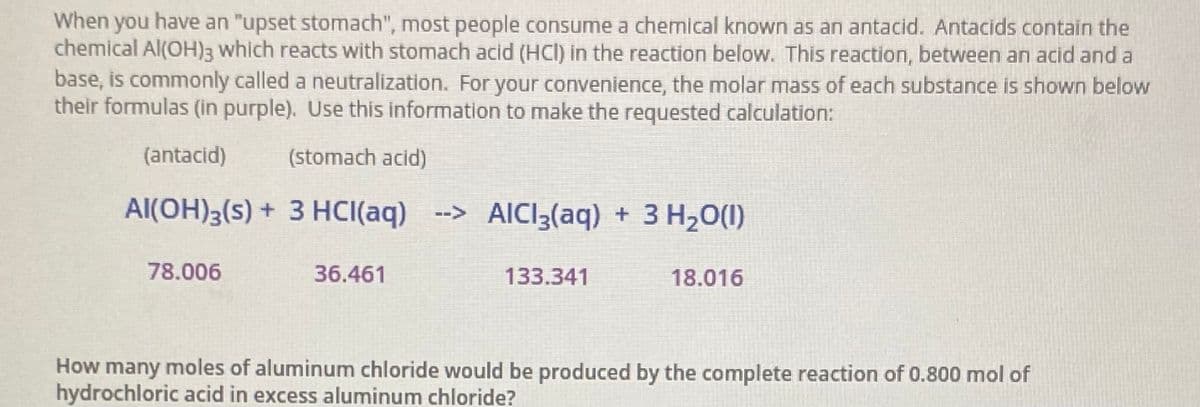When you have an "upset stomach", most people consume a chemical known as an antacid. Antacids contain the chemical Al(OH)3 which reacts with stomach acid (HCl) in the reaction below. This reaction, between an acid and a base, is commonly called a neutralization. For your convenience, the molar mass of each substance is shown below their formulas (in purple). Use this information to make the requested calculation: (antacid) (stomach acid) Al(OH)3(s) + 3 HCI(aq) --> AICI3(aq) + 3 H20(1) 78.006 36.461 133.341 18.016 How many moles of aluminum chloride would be produced by the complete reaction of 0.800 mol of hydrochloric acid in excess aluminum chloride?
When you have an "upset stomach", most people consume a chemical known as an antacid. Antacids contain the chemical Al(OH)3 which reacts with stomach acid (HCl) in the reaction below. This reaction, between an acid and a base, is commonly called a neutralization. For your convenience, the molar mass of each substance is shown below their formulas (in purple). Use this information to make the requested calculation: (antacid) (stomach acid) Al(OH)3(s) + 3 HCI(aq) --> AICI3(aq) + 3 H20(1) 78.006 36.461 133.341 18.016 How many moles of aluminum chloride would be produced by the complete reaction of 0.800 mol of hydrochloric acid in excess aluminum chloride?
Chemistry: An Atoms First Approach
2nd Edition
ISBN:9781305079243
Author:Steven S. Zumdahl, Susan A. Zumdahl
Publisher:Steven S. Zumdahl, Susan A. Zumdahl
Chapter7: Chemical Energy
Section: Chapter Questions
Problem 134IP: On Easter Sunday, April 3, 1983, nitric acid spilled from a tank car near downtown Denver, Colorado....
Related questions
Question

Transcribed Image Text:When you have an "upset stomach", most people consume a chemical known as an antacid. Antacids contain the
chemical Al(OH)3 which reacts with stomach acid (HC) in the reaction below. This reaction, between an acid and a
base, is commonly called a neutralization. For your convenience, the molar mass of each substance is shown below
their formulas (in purple). Use this information to make the requested calculation:
(antacid)
(stomach acid)
Al(OH)3(s) + 3 HCI(aq) --> AICI3(aq) + 3 H,0(1)
78.006
36.461
133.341
18.016
How many moles of aluminum chloride would be produced by the complete reaction of 0.800 mol of
hydrochloric acid in excess aluminum chloride?

Transcribed Image Text:When you have an "upset stomach", most people consume a chemical known as an antacid. Antacids contain the
chemical Al(OH)3 which reacts with stomach acid (HCI) in the reaction below. This reaction, between an acid and a
base, is commonly called a neutralization. For your convenience, the molar mass of each substance is shown below
their formulas (in purple). Use this information to make the requested calculation:
(antacid)
(stomach acid)
Al(OH)3(s) + 3 HCI(aq) --> AICI3(aq) + 3 H20(1)
78.006
36.461
133.341
18.016
If the reaction produces 0.800 g of water, what mass of antacid, in mg, was consumed?
Expert Solution
This question has been solved!
Explore an expertly crafted, step-by-step solution for a thorough understanding of key concepts.
This is a popular solution!
Trending now
This is a popular solution!
Step by step
Solved in 2 steps with 2 images

Knowledge Booster
Learn more about
Need a deep-dive on the concept behind this application? Look no further. Learn more about this topic, chemistry and related others by exploring similar questions and additional content below.Recommended textbooks for you

Chemistry: An Atoms First Approach
Chemistry
ISBN:
9781305079243
Author:
Steven S. Zumdahl, Susan A. Zumdahl
Publisher:
Cengage Learning

Chemistry
Chemistry
ISBN:
9781305957404
Author:
Steven S. Zumdahl, Susan A. Zumdahl, Donald J. DeCoste
Publisher:
Cengage Learning


Chemistry: An Atoms First Approach
Chemistry
ISBN:
9781305079243
Author:
Steven S. Zumdahl, Susan A. Zumdahl
Publisher:
Cengage Learning

Chemistry
Chemistry
ISBN:
9781305957404
Author:
Steven S. Zumdahl, Susan A. Zumdahl, Donald J. DeCoste
Publisher:
Cengage Learning


Introductory Chemistry: A Foundation
Chemistry
ISBN:
9781337399425
Author:
Steven S. Zumdahl, Donald J. DeCoste
Publisher:
Cengage Learning

Chemistry: The Molecular Science
Chemistry
ISBN:
9781285199047
Author:
John W. Moore, Conrad L. Stanitski
Publisher:
Cengage Learning

Chemistry for Engineering Students
Chemistry
ISBN:
9781337398909
Author:
Lawrence S. Brown, Tom Holme
Publisher:
Cengage Learning